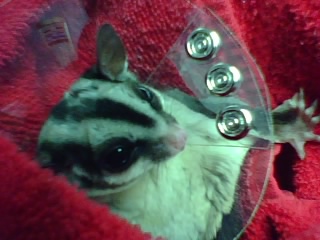originally posted June 29, 2009:
It's always an emotional time when we lose an animal. We hope that they didn't suffer and that we did our best for them while they were alive. Even though they are gone, there is still one more thing we can do: a necropsy. A necropsy is our best chance to attain more knowledge that can help all gliders, and this learning is acheived with no cost to life. There is no pain or suffering involved for the animal. While necropsies can answer many questions, they also push us to question more. We adapt our practices based on our knowledge...what we learn to be the very best for gliders. Much of that learning comes from studying the necropsy reports. Death is never desired, and it cannot be stopped, but it is something we can learn from. Maybe the knowledge we gain from the death can prolong the quality of life for others.
Much of the hesitation to have a necropsy done is often for not knowing what that means...what will happen. It's important to knwo that you do not have to witness the necropsy. While there are some of us who request to be present, most prefer not to be. The vet will do an external exam looking for obvious injuries/pathology. Then they will do an internal exam by opening the chest/stomach side. He/she will examine the gross pathology of the organs looking for changes in color/texture/structure. Changes begin immediately upon death which is why it is so important to preserve the glider's body immediately by refrigerating. By slowing down the body's natural breakdown, we can get better results from the necropsy. The vet will remove several tissue samples to send to the lab for histopathology. Results from this can take a few days to receive. The vet will then suture the incision closed . You can still have your glider to bury if you desire. It's important to note that your glider will not look much different after necropsy. It's only the incision on the stomach that is visible, but most vets are happy to wrap your glider in a fleece blanket or pouch if you provide one.
Sometimes, the expense of the necropsy stops owners from having one performed. The Necropsy Effort is working on helping to ease the financial cost of necropsy and histopathology. (for more information on this, please contact Val/Something_To_Believe_In; Shawna/USMom; or Kate/thefotokat). For others, it's the emotions that overwhelm them. As hard as it is, the benefits of the necropsy are tremendous. It is your chance to help other gliders. Nothing can bring back your sweet glider, but this is a way to give hope to other gliders. If every single person who lost a glider had a necropsy performed, and sent those results to The Necropsy Effort, we would gain so much knowledge. Necropsies are our only way to gather this type of information. It is only after death that it is humane to research. To do otherwise has too high a price on life. Necropsies are a respectful learning tool.
